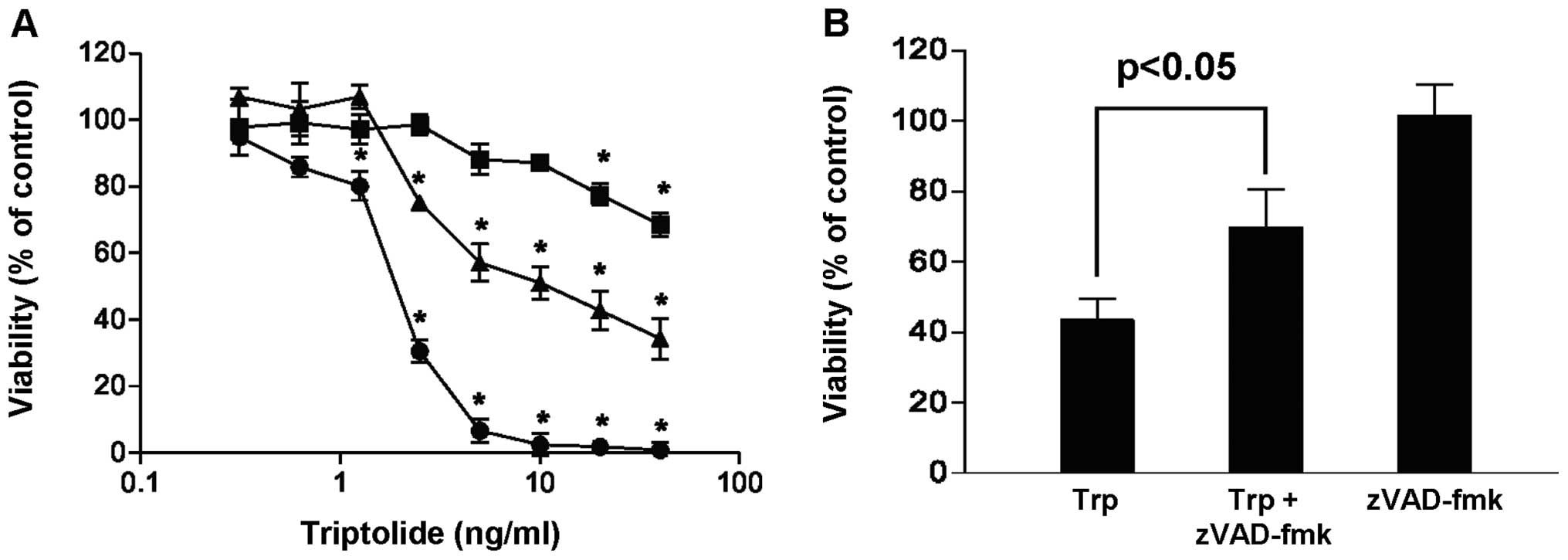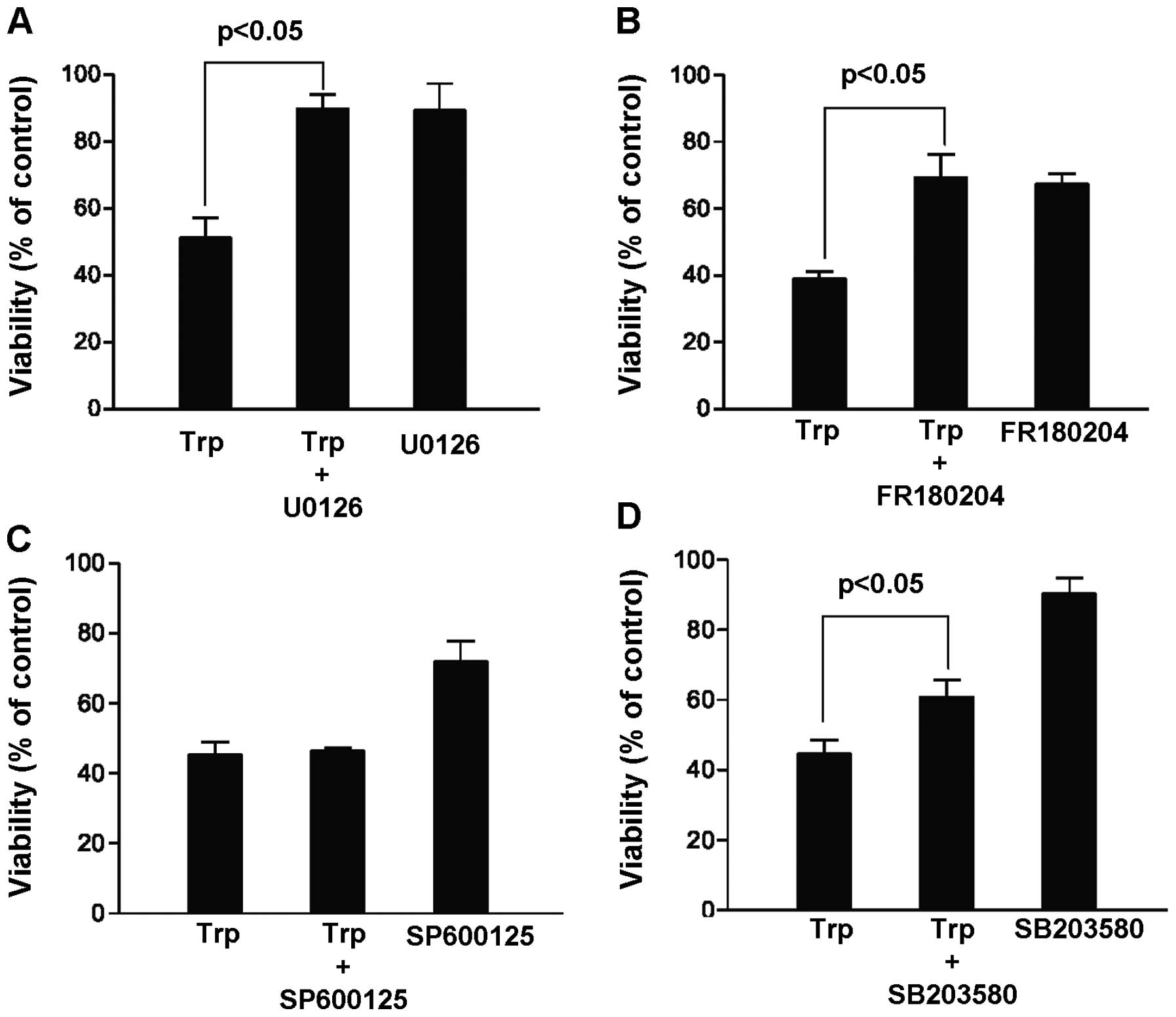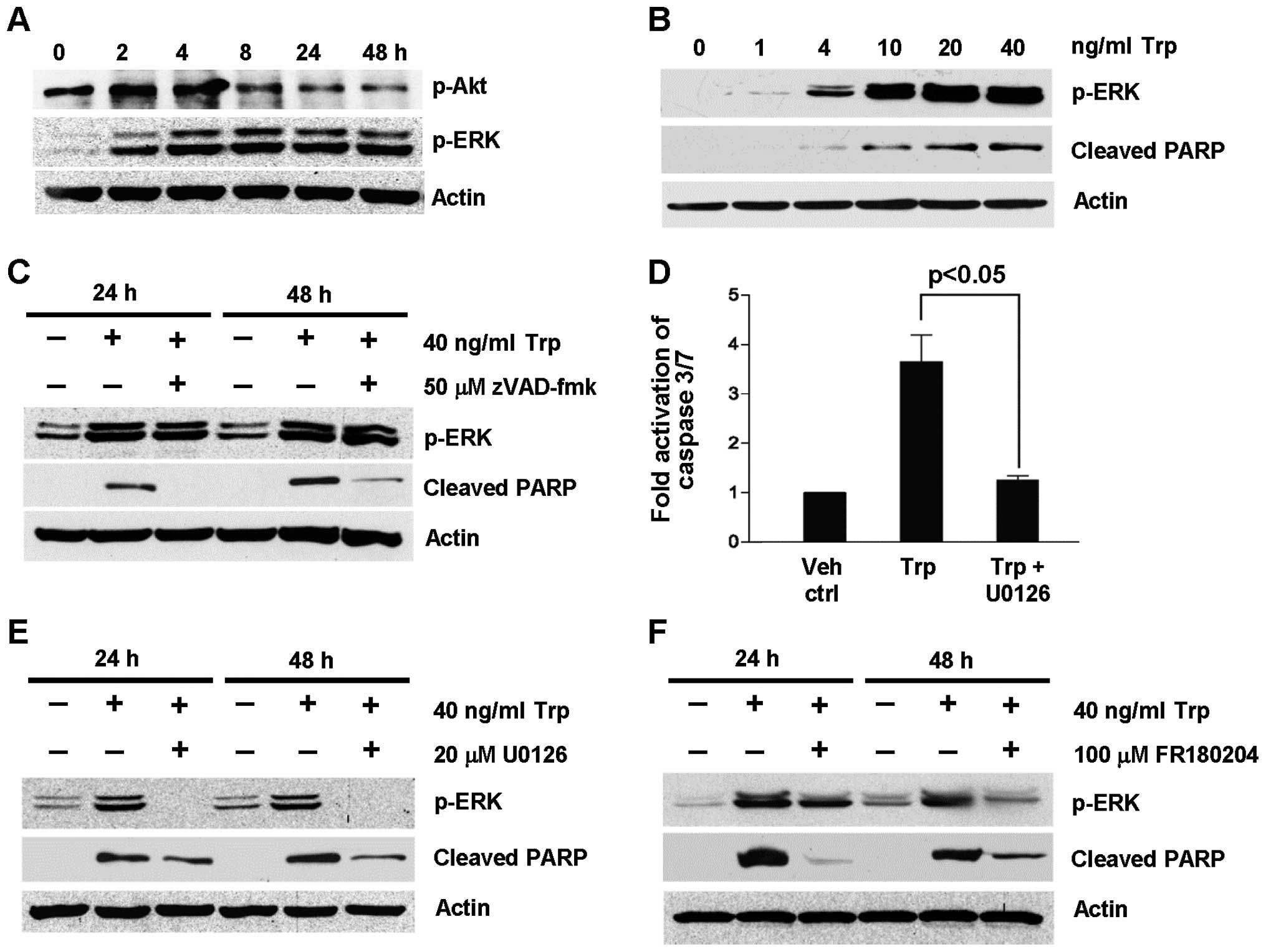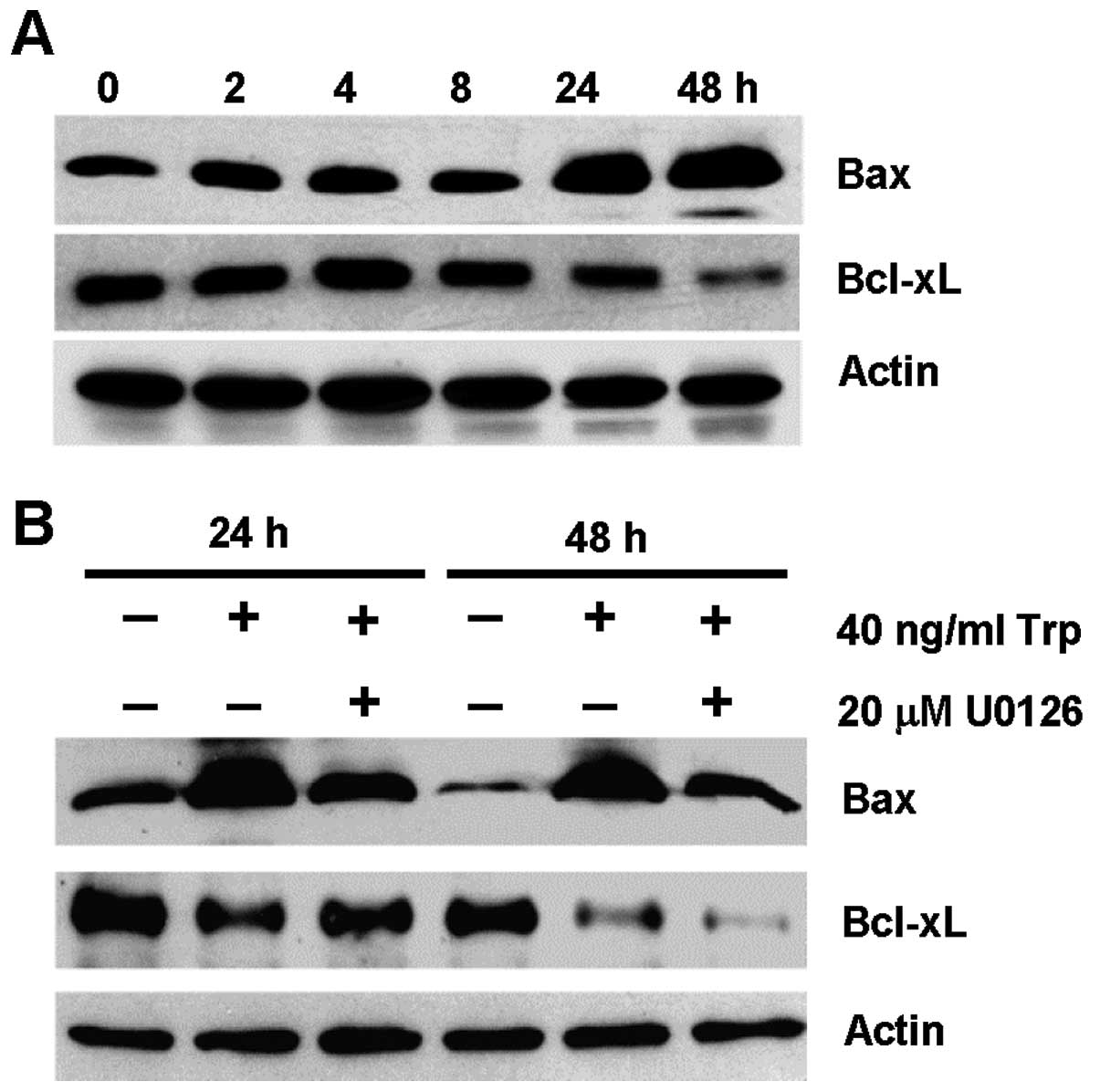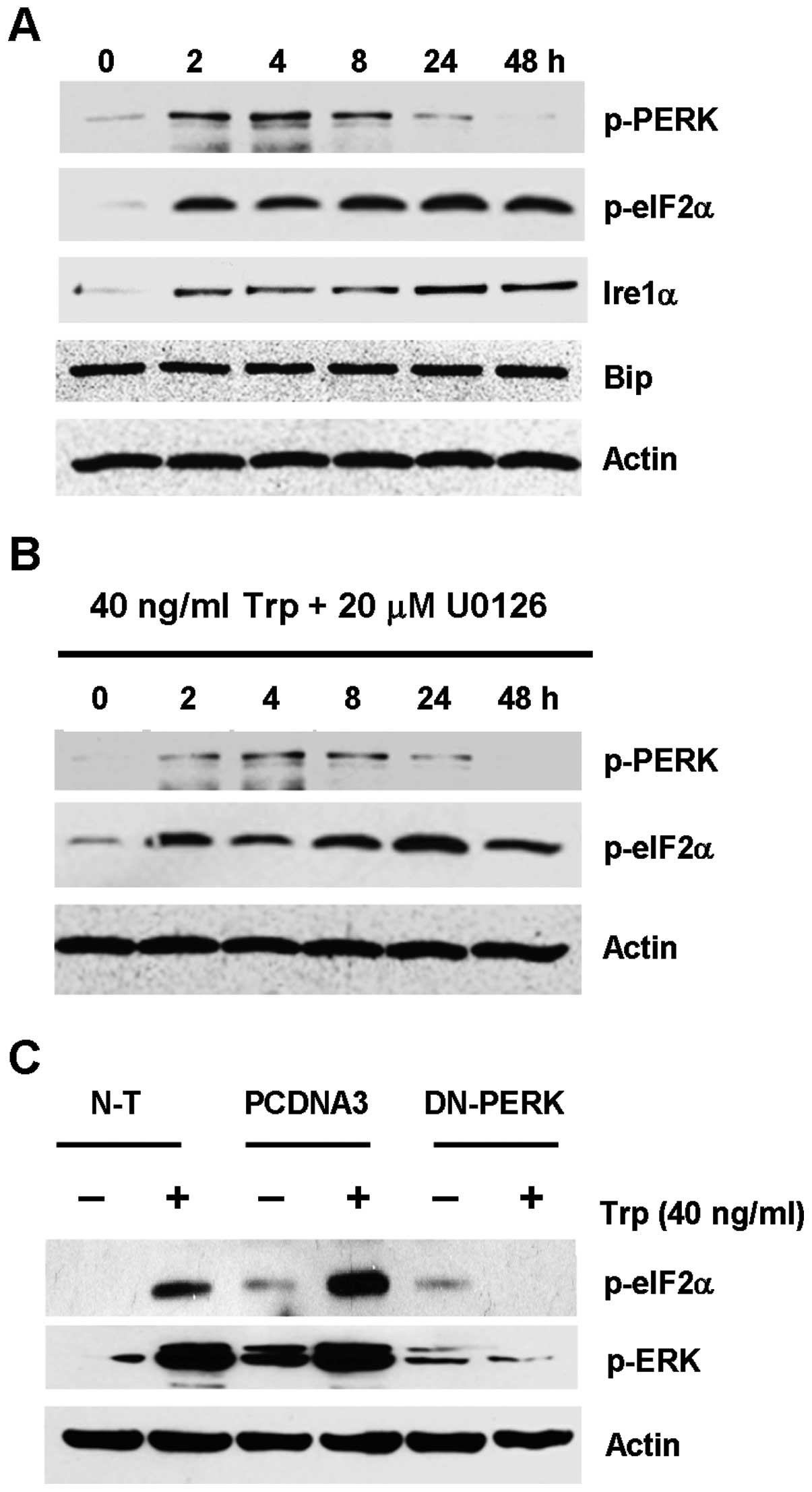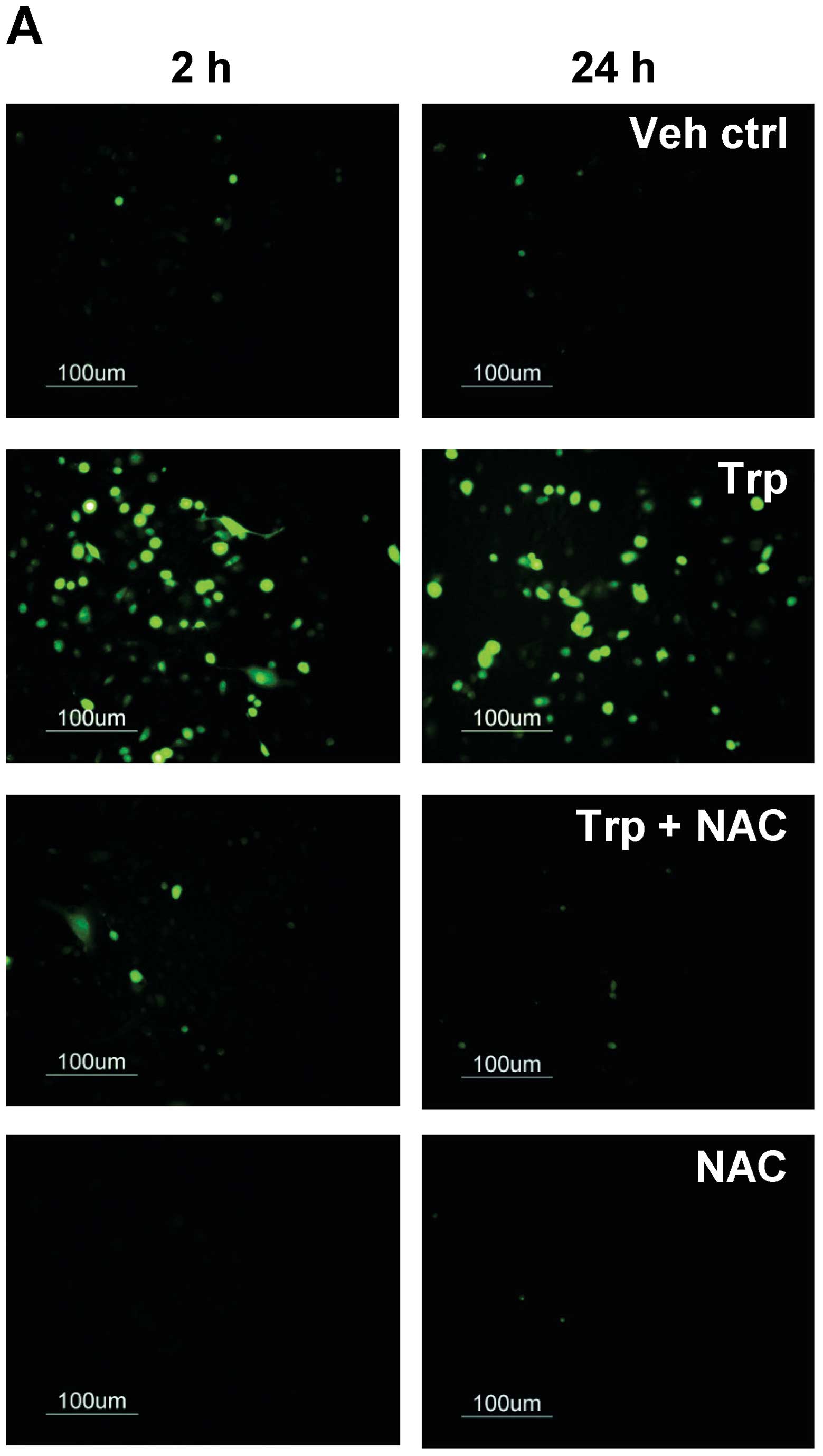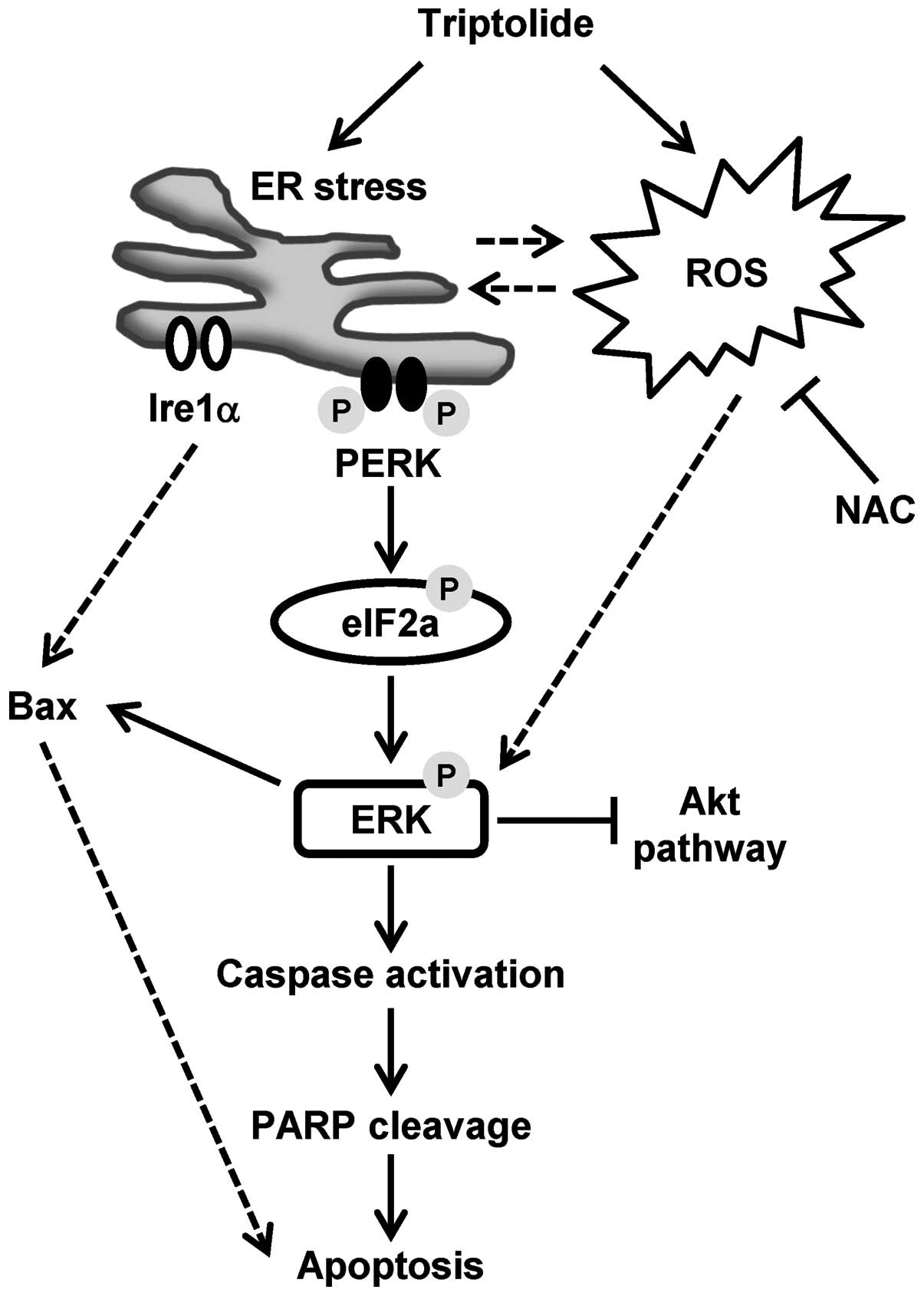Role of oxidative stress, endoplasmic reticulum stress and ERK activation in triptolide-induced apoptosis
- Authors:
- Published online on: March 1, 2013 https://doi.org/10.3892/ijo.2013.1843
- Pages: 1605-1612
Abstract
Introduction
Historically, the Chinese herb, Tripterygium wilfordii Hook F., has been used in Chinese medicine for centuries and triptolide which is a diterpenoid triepoxide extracted from this herb has been shown to possess immunosuppressive, anti-inflammatory and anti-fertility properties (1–3). In addition, triptolide has been shown to have promising anticancer effects on various human cancer models in vitro and in vivo(4–6), with potency in the nanomolar range. Given the promising aspects in anticancer therapy, a water-soluble analogue of triptolide, PG490-88 Na, has been developed with improved toxicity profile and has entered into a phase I clinical trial for the treatment of prostate cancer.
Through the research effort since its first isolation from the herb, triptolide has been shown to be a multi-target anticancer agent. The molecular pathways modulated by trip-tolide that result in antiproliferative and pro-apoptotic effects include i) inhibition of the transcriptional activity of NF-κB and AP-1 (5,6); ii) blocking of TNF-α mediated induction of c-IAP1 and c-IAP2 (5,6); iii) suppression of p21 and PI3K expression (7–9); iv) inhibition of HSP70 (10); v) reduction of XIAP and Mcl-1 (11); vi) inhibition of global transcription via RNA polymerase II degradation (12); and vii) downregulation of SUMO-specific protease 1 (13). Furthermore, triptolide can sensitize cancer cells to Apo2L/Trail, TNF-α and chemotherapeutic agents-induced apoptosis (4,6,7,14).
Mitogen-activated protein kinases (MAPK) are well known to be involved in mediating cell survival. The role of ERK has been controversial in which its activation could result in cell proliferation and cell death. It was reported that the activation of ERK could be a result of DNA damage that subsequently leads to cell cycle arrest and apoptosis (15,16). In addition, ERK activation has been suggested to be a response to counteract endoplasmic reticulum (ER) stress-induced apoptosis (17,18), which could be induced by external stimuli such as cytotoxic agents. While there are studies on the ability of triptolide to modulate the MAPK signaling pathways (9,14,19), data on the effect of triptolide on ERK activation and subsequent cellular responses remain limited. Recently, triptolide has been shown to induce the generation of reactive oxygen species (ROS) and nitric oxide leading to apoptosis in macrophage-like cell lines (20) as well as in colorectal cancer cell lines (21). Given the ability of intracellular ROS to activate ERK and subsequent apoptosis (22–25), it would be of interest to investigate if triptolide-induced apoptosis involves ROS generation and ERK activation.
In view of the above findings, it was hypothesized that triptolide could induce ROS generation, ER stress and ERK activation, all of which were novel cellular events leading to apoptosis in cancer cells. Using a variety of strategies in the present study, we have shown for the first time that ERK activation occurred in a dose- and time-dependent manner following triptolide treatment and is an important mediator of triptolide-induced apoptosis. Furthermore, triptolide could induce oxidative stress and ER stress predominantly via the PERK-eIF2α pathway which acted upstream of ERK activation.
Materials and methods
Chemicals and antibodies
Triptolide, Bapta-AM, N-acetylcysteine (NAC), 2′7′-dichlorodihydrofluorescein diacetate (H2DCFDA) and antibody for β-actin were purchased from Sigma-Aldrich (St. Louis, MO, USA). FR180204, SP600125, SB203580 and zVAD-fmk were purchased from Calbiochem (San Diego, CA, USA). U0126 and antibodies for p-ERK42/44, p-eIF2α, cleaved PARP, Bax, Bcl-xL and Ire1α were purchased from Cell Signaling Technology (Beverly, MA, USA). Anti-p-PERK T981 was purchased from Santa Cruz Biotechnology (Santa Cruz, CA, USA). Anti-Bip was purchased from BD Transduction Laboratories (Franklin Lakes, NJ, USA). Goat anti-mouse IgG and goat anti-rabbit IgG secondary antibodies conjugated with horseradish peroxidase were from Thermo Scientific (Rockford, IL, USA). Dominant negative PERK plasmid was kindly provided by Professor Wong Nai Sum (University of Hong Kong, Hong Kong, China).
Cell culture
The human breast carcinoma cell line MDA-MB-231 was obtained from American Type Cell Culture Collection (Manassas, VA, USA). The cells were grown in RPMI-1640 (Sigma-Aldrich) containing 10% (v/v) fetal bovine serum (HyClone, Logan, UT, USA) supplemented with 100 U/ml each of penicillin and streptomycin (Invitrogen, Carlsbad, CA, USA) at 37°C in a humidified 5% CO2 atmosphere. Cells from less than 20 passages were used for the experiments.
MTT viability assay
For MTT assay, cells were seeded in 96-well plates at a density of 1.3±104, 9±103 and 5±103 cells per well for the 24, 48 and 72-h treatment, respectively. The medium was changed to 200 μl of medium containing 0.31–40 ng/ml triptolide the following day. Dimethyl sulf-oxide (DMSO) 0.04% in culture medium was used as the vehicle control. At the end of treatment, 50 μl of 1 mg/ml MTT (MP Biomedicals, Solon, OH, USA), prepared in cell culture medium, was added to each well and the plate was incubated at 37°C for 4 h. Subsequently, the medium was aspirated and 150 μl of DMSO was added and the plate was shaken at 200 rpm until the purple-blue formazan solubilized. Absorbance at 570 nm was then measured using Tecan Sunrise plate reader. For the effect of various MAPK inhibitors on cell viability, cells were seeded at a density of 2±105 per well in a 96-well plate. On the following day, the cells were serum-starved for 24 h before treatment with 40 ng/ml triptolide in the presence or absence of the inhibitor for 48 h. Cell viability was determined using MTT as described above.
Caspase activity assay
Cells were seeded in 96-well plate at a density of 2±105 cells/well and allowed to attach overnight. On the following day, the medium was removed and replaced with serum-free media, and the cells were incubated for 24 h. Subsequently, triptolide (40 ng/ml) with and without 20 μM U0126 was added to each well and the cells were treated for 48 h. At the end of treatment, caspase activity was measured using the Apo-One Homogeneous Caspase-3/7 assay kit (Promega, Madison, WI, USA) according to the manufacturer’s instructions. The fluorescence signal was measured using an excitation wavelength of 499 nm and an emission wavelength of 521 nm after incubation at room temperature for 5 h.
DNA content determination by flow cytometry
Cells with or without treatment were harvested with trypsin, washed with ice-cold PBS and pelleted at 10,000 rpm for 1 min. Next, the cells were resuspended and fixed in 70% ice-cold ethanol overnight at −20°C after which the cells were collected by centrifugation at 10,000 rpm for 1 min and the supernatant was aspirated. The pellet was then resuspended in propidium iodide (PI) staining buffer consisted of 50 μg/ml PI (Invitrogen), 1 mg/ml DNase-free RNase (Applichem, Darmstadt, Germany) and 0.1% Triton X-100 prepared in PBS before incubation at 37°C for 15 min followed by 1 h on ice. The samples were then analyzed with Beckman Altra Flow Cytometry with 10,000 events taken. Apoptotic cells represented by the fraction at the sub-G0/G1 phase were evaluated.
Western blot analysis
Cells were seeded in a 6-well plate at a density of 7×105 cells per well. After treatment, floating cells and attached cells were harvested and lysed using ice-cold lysis buffer (20 mM Tris, pH 7.5, 150 mM NaCl, 10 mM EDTA, 1% (v/v) NP-40, 20 mM sodium fluoride, 5 mM sodium pyrophosphate, 1 mM sodium vanadate, 10% (v/v) glycerol, protease inhibitor cocktail) and cleared by centrifugation at 20,000 x g for 20 min at 4°C. Protein concentrations were determined by Bio-Rad Protein Assay, and equal amount of protein (50 μg) was electrophoresed on SDS-polyacrylamide gels and transferred onto nitrocellulose membrane. Membranes were blocked with 5% BSA or 5% milk in Tris-buffered saline with Tween-20-buffered solution (150 mM NaCl, 10 mM Tris-HCl, pH 7.5, 0.1% Tween-20) before probing with primary antibody according to the instructions of the manufacturer. Subsequently, the membranes were incubated with the corresponding horseradish peroxidase conjugated secondary antibody for 1 h. Protein bands were detected by enhanced ECL reagent (Thermo Scientific), and visualized by CL-Xposure film (Thermo Scientific). For reprobing, blots were stripped with Restore Western Blot stripping buffer (Thermo Scientific).
Cell transfection
MDA-MB-231 cells were seeded in 6-well plates 24 h before transfection. For each well, transient transfection was done by mixing 2.5 μg plasmid DNA and 2.5 μλ PLUS™ Reagent (Invitrogen) in 500 μl of Opti-MEM® I reduced serum media (Invitrogen) and incubated at room temperature for 15 min. A total of 10 μl of Lipofectamine LTX™ reagent (Invitrogen) was then added to the mixture with gentle mixing. The mixture was incubated at room temperature for 30 min before being added to a single well of cells containing 2 ml fresh complete medium. After 30 h post-transfection, the complete medium was removed, and the cells were treated with 40 ng/ml triptolide in serum-free media for 4 h. The expression of p-eIF2α and p-ERK were analyzed via western blot analysis.
Intracellular ROS detection
Cell culture medium without phenol red was used for the following experiment. MDA-MB-231 cells were seeded in a 96-well plate at a density of 2×104 cells per well. On the following day, the cells were serum-starved for 24 h before treatment with 200 μl of 40 ng/ml of triptolide for 2 and 24 h in serum-free media with and without 1 mM NAC, respectively. After treatment, the medium was aspirated and intracellular ROS was detected using H2DCFDA. H2DCFDA in serum-free medium was added to the cells at a final concentration of 5 μM and incubated at 37°C in CO2 incubator for 30 min. After 30 min, the medium containing H2DCFDA was removed and the cells were washed three times with serum-free medium. Intracellular ROS was detected via fluorescence microscope using Nikon eclipse TE 2000-U.
Results
Triptolide induced time-, concentration- and caspase-dependent cell death
The effect of triptolide on the viability of MDA-MB-231 cells was investigated as a function of exposure time and drug concentration. Fig. 1A shows that the addition of triptolide reduced the viability of MDA-MB-231 cells in a concentration- and time-dependent manner when compared with the vehicle control. At the maximum concentration tested (40 ng/ml triptolide), viability of cells decreased to 68, 34 and 0% when treated for 24, 48 and 72 h, respectively. Furthermore, when cells were treated with triptolide in the presence of the broad caspase inhibitor, zVAD-fmk, more cells survived (Fig. 1B), suggesting that triptolide induced cell death via caspase activation. These results are in line with previous study reporting the apoptosis-inducing effect of triptolide in cancer cells.
ERK activation rather than inhibition was critical to triptolide-induced cell death
MAP kinase pathways are known to play important roles in the regulation of cancer cell survival and proliferation. Yet, it remains unclear whether triptolide-induced cell death was caused by the modulation of any of these pathways. It was thus hypothesized that inhibiting the MAP kinase pathways during triptolide exposure would sensitize the cancer cells to triptolide and result in more cancer cell kill. In this case, MDA-MB-231 cells were treated for 48 h with 40 ng/ml triptolide in the presence and absence of various MAP kinase inhibitors, including MEK inhibitor U0126 (20 μM), ERK inhibitor FR180204 (100 μM), JNK inhibitor SP600125 (20 μM) and p38 kinase inhibitor SB203580 (20 μM). Contrary to our hypothesis, our results summarized in Fig. 2 indicated that the cell killing effect of triptolide could be reversed in the presence of the MEK, ERK and p38 kinase inhibitors. In particular, among the three MAP kinase pathways, inhibition of the MEK/ERK pathway appeared to give the highest increase in the percentage of viable cells upon triptolide exposure. This finding suggests that ERK activation rather than inhibition was critical to triptolide-induced cell death, and our subsequent experiments were focused on the role of ERK activation in hope to elucidate novel mechanisms mediating the cytotoxicity of triptolide.
Triptolide-induced caspase activation is downstream of ERK activation
To further support that ERK activation was induced by triptolide treatment, the expression of p-ERK was probed as a function of triptolide exposure time (Fig. 3A) and concentration (Fig. 3B). As shown in Fig. 3A, ERK was phosphorylated as early as 2 h after triptolide treatment and remained phosphorylated for 48 h. This was accompanied by the concomitant reduction in phosphorylated Akt expression. Furthermore, ERK phosphorylation was dependent on trip-tolide concentration (Fig. 3B). To determine if ERK activation took place upstream or downstream of caspase activation to exert its apoptotic effect, the expression levels of p-ERK and cleaved PARP were determined under the inhibition of caspases using broad-spectrum caspase inhibitor, zVAD-fmk, as well as the inhibition of the MEK/ERK pathway U0126 and FR180204. As shown in Fig. 3C, zVAD-fmk did not inhibit triptolide-induced ERK activation at 24 and 48 h despite the inhibition of PARP cleavage. On the contrary, the fold activation of caspase 3/7 induced by triptolide treatment was significantly reduced in the presence of U0126 (Fig. 3D). These results indicate that ERK activation was upstream of caspase activation. To further confirm this observation, the effect of U0126 and FR180204 on caspase activation was evaluated by probing the expression of cleaved PARP in triptolide-treated cells at 24 and 48 h. As shown in Fig. 3E and F, triptolide-induced PARP cleavage was reduced in the presence of the MEK/ERK pathway inhibitors, U0126 and FR180204, with the concomitant reduction in p-ERK expression. Collectively, these findings provide further evidence for the role of ERK activation in triptolide-induced apoptosis.
Triptolide-induced ERK activation modulated the expression of Bcl-2 protein members
The mitochondrial death pathway is known to be controlled by the members of the Bcl-2 family, and it has been reported that triptolide initiates apoptosis via the mitochondria-mediated intrinsic apoptotic pathway (11,26). It has also been demonstrated that Bax expression could be mediated by ERK activation upon cisplatin treatment (27). In view of the ability of triptolide to induce ERK activation and subsequent caspase-dependent cell death, it is of interest to determine if ERK activation modulates the expression of Bcl-2 family members. Fig. 4A shows the expression of the pro-apoptotic Bax protein and the anti-apoptotic Bcl-xL protein in MDA-MB-231 cells over a time course of 48 h upon triptolide treatment. Bax was upregulated after 24 and 48 h of triptolide treatment, with concomitant downregulation of Bcl-xL at 24 and 48 h. These results suggest that changes in Bax and Bcl-xL protein expression occurred downstream of ERK activation, which occurred as early as 2 h (Fig. 3A). To further support this notion, the expression of Bax and Bcl-xL in triptolide-treated cells was evaluated in the presence of U0126 inhibitor. As shown in Fig. 4B, triptolide-induced Bax expression was inhibited partially in the presence of U0126. However, the reduction in Bcl-xL expression induced by triptolide treatment could be independent of ERK activation.
Triptolide induces ER stress with PERK-eIF2α pathway acting upstream of ERK activation
From the data collected thus far, ERK activation induced by triptolide treatment was linked to downstream pathways involving Bax, caspase activation and subsequent cell death. It is of interest to determine the possible upstream signaling pathways that lead to ERK activation upon triptolide treatment. ERK activation has been implicated as a response to counteract ER stress (17,18), and it was thus hypothesized that triptolide could induce ER stress in treated cells resulting in ERK activation. MDA-MB-231 cells were treated with 40 ng/ml triptolide over a time course of 48 h, and the expression levels of common markers of ER stress, including PERK, eIF2α, Ire1α and Bip, were evaluated. As shown in Fig. 5A, p-PERK in triptolide-treated cells was transiently upregulated from 2 to 8 h, which gradually decreased to basal level after 24 h. The upregulation of p-PERK was seen with the concomitant upregulation of its downstream effector, eIF2α, which remained phosphorylated from 2 h to 48 h. Upregulation of Ire1α was also observed, while no change in Bip expression was seen for all the time points tested.
To further test the hypothesis that ER stress could lead to ERK activation in triptolide-treated cells, ERK and PERK were inhibited by the MEK inhibitor U0126 and by transfecting the cells with the dominant negative PERK plasmid, respectively, so as to dissect which kinase was acting more upstream. As shown in Fig. 5B, the use of U0126 had no inhibitory effect on the expression of p-PERK and p-eIF2α. This finding indicated that ERK activation seemed to act downstream of the activation of ER stress markers. On the contrary, triptolide treatment in the MDA-MB-231 cells that were transfected with the dominant negative PERK plasmid showed substantial reduction in ERK activation, as compared to the non-transfected cells or cells transfected with empty plasmid (Fig. 5C). Taken together, these results indicated that triptolide induced ER stress presumably through the PERK-eIF2α pathway, which would result in downstream ERK activation.
The role of reactive oxygen species in triptolide-induced ERK activation and cell death
Accumulating lines of evidence suggest that ER stress could be associated with the generation of ROS and induce apoptosis (28,29). Since it was shown previously that triptolide can induce ER stress, we sought to determine if ROS was generated in triptolide-treated cells during ER stress. As shown in Fig. 6A, ROS were generated as early as 2 h when cells were treated with triptolide, as reflected by the increase in fluorescent signal. Co-treatment with 1 mM NAC abolished the fluorescent signals in triptolide-treated cells at 2 and 24 h, providing further evidence for the ability of triptolide to induce ROS generation. To further determine the involvement of ROS in triptolide-induced ERK activation and cell viability, p-ERK and cell viability were evaluated. With the co-treatment of NAC, the phosphorylation of ERK was substantially reduced in triptolide-treated cells (Fig. 6B), and the percentage of apoptotic cells was also significantly reduced, as reflected by the reduction in the percentage of cells in the sub-G0/G1 phase from 18.2±2.0 to 11.0±0.7% at 48 h post-triptolide treatment (Fig. 6C). These findings show that ROS was upstream of triptolide-induced ERK activation and subsequent apoptosis.
Discussion
Triptolide, a diterpene triepoxide isolated from the medicinal plant Tripterygium wilfordii Hook F., was first reported to have anti-leukemic properties in 1972 (30). Over the last few decades, intensive research efforts have been devoted to the elucidation of the molecular effects underlying the anticancer effects of triptolide. Lines of evidence accumulated from in vitro and in vivo studies pointed to the ability of triptolide to directly induce apoptosis in various cancer types via multiple targets (31). Our current study is the first to report yet another novel mechanism by which triptolide induced cancer cell apoptosis. Specifically, triptolide was shown to induce ROS generation and ER stress via the PERK-eIF2α pathway that subsequently activated ERK and resulted in caspase-dependent apoptosis. Our proposed model of triptolide-induced caspase-dependent apoptosis is presented in Fig. 7, with the following sections focused on the discussion of the role of ERK activation in relation to ROS generation, ER stress and eventual apoptosis.
ERK signaling is part of the MAPK superfamily, and is well known for its ability to modulate cell survival in response to external stimuli. Recent studies have suggested a more complicated role of ERK in which its activation could promote cell death in some cell types under certain conditions. In particular, ERK was selectively activated in neuronal and renal epithelial cells upon exposure to oxidative stress and toxicants such as cisplatin, and inhibition of the ERK pathway blocks apoptosis (32). As triptolide is known to cause ROS generation (20,21), it is interesting to note that triptolide-induced ERK activation was partly mediated through ROS generation, and this observation, as summarized in Fig. 6, is similar to those reported for cisplatin (24). In view of the synergistic, anticancer effect of the triptolide/cisplatin combination (8,33), ERK activation could be another molecular mechanism underlying the synergism of this drug combination that is yet to be further characterized using in vitro and in vivo models.
The ability of triptolide to induce persistent ROS generation could trigger the unfolded protein response which is a cellular mechanism for the adaptation to homeostatic changes such as redox status alteration. Protein misfolding as a result of oxidative stress, which is indicative of perturbation of ER homeostasis, has been implicated to initiate apoptosis (29). Our data demonstrate that triptolide was able to induce ER stress selectively via the PERK-eIF2α pathway which is often activated by oxidant stimuli. Furthermore, ERK activation was shown to act downstream of the PERK-eIF2α pathway. These observations are in line with previous studies that demonstrate the activation of ERK by ER stress inducers and subsequent apoptosis (17,34). While JNK could be activated during ER stress that was mediated by Ire-1α (34,35), our data did not support the notion that JNK was activated as a result of the activation of Ire-1α, as the JNK inhibitor, SP600125, did not reverse triptolide-induced cancer cell killing.
In our study, inhibiting ERK activation by U0126 partially inhibited triptolide-induced Bax expression but had no significant effect on Bcl-xL expression (Fig. 4). Furthermore, inhibition of Bax overexpression with U0126 inhibitor was sufficient to overcome triptolide-induced cancer cell killing. This suggests that triptolide-induced ERK activation initiates apoptosis rather than survival, since it only regulates the pro-apoptotic protein Bax without substantial influence on the anti-apoptotic protein Bcl-xL. This is consistent with a previous report that ERK may act upstream of the Bcl-2 family (32,36). In addition to the association of ERK with the pro-apoptotic Bax that regulates apoptosis, it has been suggested that promotion of cell death by ERK activation could be related to the suppression of the PI3K/Akt pathway which is the critical survival signaling pathway in cells (32). The results presented in Fig. 3A are consistent with this notion, and ERK activation could serve as a negative feedback signal to downregulate p-Akt to suppress its anti-apoptotic effects, as ERK activation occurred earlier than downregulation of p-Akt. This notion is further supported by Dai et al that there was cross-talk between PI3K/Akt and MEK/ERK pathways when mediating ER stress-induced cell cycle progression and cell death in human hepatocellular carcinoma cells (37).
In summary, we have shown that ERK activation is a novel mechanism by which triptolide induced apoptosis in MDA-MB-231 breast cancer cells. In addition to ROS generation, we have shown for the first time that triptolide induced ER stress via the PERK/eIF2α pathway, which could have important implications in the design and further development of triptolide as an ER stress inducer for anticancer therapy.
Acknowledgements
This study was supported by the National Medical Research Council of Singapore through an IRG research grant (NMRC/1109/2007).
References
|
Chen BJ: Triptolide, a novel immunosuppressive and anti-inflammatory agent purified from a Chinese herb Tripterygium wilfordii Hook F. Leuk Lymphoma. 42:253–265. 2001. View Article : Google Scholar : PubMed/NCBI | |
|
Lue Y, Sinha Hikim AP, Wang C, et al: Triptolide: a potential male contraceptive. J Androl. 19:479–486. 1998.PubMed/NCBI | |
|
Qiu D, Zhao G, Aoki Y, et al: Immunosuppressant PG490 (trip-tolide) inhibits T-cell interleukin-2 expression at the level of purine-box/nuclear factor of activated T-cells and NF-kappaB transcriptional activation. J Biol Chem. 274:13443–13450. 1999. View Article : Google Scholar : PubMed/NCBI | |
|
Fidler JM, Li K, Chung C, et al: PG490-88, a derivative of triptolide, causes tumor regression and sensitizes tumors to chemotherapy. Mol Cancer Ther. 2:855–862. 2003.PubMed/NCBI | |
|
Jiang XH, Wong BC, Lin MC, et al: Functional p53 is required for triptolide-induced apoptosis and AP-1 and nuclear factor-kappaB activation in gastric cancer cells. Oncogene. 20:8009–8018. 2001. View Article : Google Scholar : PubMed/NCBI | |
|
Lee KY, Chang W, Qiu D, et al: PG490 (triptolide) cooperates with tumor necrosis factor-alpha to induce apoptosis in tumor cells. J Biol Chem. 274:13451–13455. 1999. View Article : Google Scholar : PubMed/NCBI | |
|
Chang WT, Kang JJ, Lee KY, et al: Triptolide and chemotherapy cooperate in tumor cell apoptosis. A role for the p53 pathway. J Biol Chem. 276:2221–2227. 2001. View Article : Google Scholar : PubMed/NCBI | |
|
Matsui Y, Watanabe J, Ikegawa M, et al: Cancer-specific enhancement of cisplatin-induced cytotoxicity with triptolide through an interaction of inactivated glycogen synthase kinase-3beta with p53. Oncogene. 27:4603–4614. 2008. View Article : Google Scholar : PubMed/NCBI | |
|
Miyata Y, Sato T and Ito A: Triptolide, a diterpenoid triepoxide, induces antitumor proliferation via activation of c-Jun NH2-terminal kinase 1 by decreasing phosphatidylinositol 3-kinase activity in human tumor cells. Biochem Biophys Res Commun. 336:1081–1086. 2005. View Article : Google Scholar | |
|
Phillips PA, Dudeja V, McCarroll JA, et al: Triptolide induces pancreatic cancer cell death via inhibition of heat shock protein 70. Cancer Res. 67:9407–9416. 2007. View Article : Google Scholar : PubMed/NCBI | |
|
Carter BZ, Mak DH, Schober WD, et al: Triptolide induces caspase-dependent cell death mediated via the mitochondrial pathway in leukemic cells. Blood. 108:630–637. 2006. View Article : Google Scholar : PubMed/NCBI | |
|
Wang Y, Lu JJ, He L, et al: Triptolide (TPL) inhibits global transcription by inducing proteasome-dependent degradation of RNA polymerase II (Pol II). PLoS One. 6:e239932011. View Article : Google Scholar : PubMed/NCBI | |
|
Huang W, He T, Chai C, et al: Triptolide inhibits the proliferation of prostate cancer cells and down-regulates SUMO-specific protease 1 expression. PLoS One. 7:e376932012. View Article : Google Scholar : PubMed/NCBI | |
|
Frese S, Pirnia F, Miescher D, et al: PG490-mediated sensitization of lung cancer cells to Apo2L/TRAIL-induced apoptosis requires activation of ERK2. Oncogene. 22:5427–5435. 2003. View Article : Google Scholar : PubMed/NCBI | |
|
Bacus SS, Gudkov AV, Lowe M, et al: Taxol-induced apoptosis depends on MAP kinase pathways (ERK and p38) and is independent of p53. Oncogene. 20:147–155. 2001. View Article : Google Scholar : PubMed/NCBI | |
|
Tang D, Wu D, Hirao A, et al: ERK activation mediates cell cycle arrest and apoptosis after DNA damage independently of p53. J Biol Chem. 277:12710–12717. 2002. View Article : Google Scholar : PubMed/NCBI | |
|
Arai K, Lee SR, van Leyen K, et al: Involvement of ERK MAP kinase in endoplasmic reticulum stress in SH-SY5Y human neuroblastoma cells. J Neurochem. 89:232–239. 2004. View Article : Google Scholar : PubMed/NCBI | |
|
Hu P, Han Z, Couvillon AD, et al: Critical role of endogenous Akt/IAPs and MEK1/ERK pathways in counteracting endoplasmic reticulum stress-induced cell death. J Biol Chem. 279:49420–49429. 2004. View Article : Google Scholar : PubMed/NCBI | |
|
Wan CK, Wang C, Cheung HY, et al: Triptolide induces Bcl-2 cleavage and mitochondria dependent apoptosis in p53-deficient HL-60 cells. Cancer Lett. 241:31–41. 2006. View Article : Google Scholar : PubMed/NCBI | |
|
Bao X, Cui J, Wu Y, et al: The roles of endogenous reactive oxygen species and nitric oxide in triptolide-induced apoptotic cell death in macrophages. J Mol Med (Berl). 85:85–98. 2007. View Article : Google Scholar : PubMed/NCBI | |
|
Xu B, Guo X, Mathew S, et al: Triptolide simultaneously induces reactive oxygen species, inhibits NF-kappaB activity and sensitizes 5-fluorouracil in colorectal cancer cell lines. Cancer Lett. 291:200–208. 2010. View Article : Google Scholar : PubMed/NCBI | |
|
Dong J, Ramachandiran S, Tikoo K, et al: EGFR-independent activation of p38 MAPK and EGFR-dependent activation of ERK1/2 are required for ROS-induced renal cell death. Am J Physiol Renal Physiol. 287:F1049–F1058. 2004. View Article : Google Scholar : PubMed/NCBI | |
|
Ramachandiran S, Huang Q, Dong J, et al: Mitogen-activated protein kinases contribute to reactive oxygen species-induced cell death in renal proximal tubule epithelial cells. Chem Res Toxicol. 15:1635–1642. 2002. View Article : Google Scholar | |
|
Wang X, Martindale JL and Holbrook NJ: Requirement for ERK activation in cisplatin-induced apoptosis. J Biol Chem. 275:39435–39443. 2000. View Article : Google Scholar | |
|
Zhuang S, Yan Y, Daubert RA, et al: ERK promotes hydrogen peroxide-induced apoptosis through caspase-3 activation and inhibition of Akt in renal epithelial cells. Am J Physiol Renal Physiol. 292:F440–F447. 2007. View Article : Google Scholar : PubMed/NCBI | |
|
Yao J, Jiang Z, Duan W, et al: Involvement of mitochondrial pathway in triptolide-induced cytotoxicity in human normal liver L-02 cells. Biol Pharm Bull. 31:592–597. 2008. View Article : Google Scholar : PubMed/NCBI | |
|
Kim YK, Kim HJ, Kwon CH, et al: Role of ERK activation in cisplatin-induced apoptosis in OK renal epithelial cells. J Appl Toxicol. 25:374–382. 2005. View Article : Google Scholar : PubMed/NCBI | |
|
Hsieh YH, Su IJ, Lei HY, et al: Differential endoplasmic reticulum stress signaling pathways mediated by iNOS. Biochem Biophys Res Commun. 359:643–648. 2007. View Article : Google Scholar : PubMed/NCBI | |
|
Malhotra JD and Kaufman RJ: Endoplasmic reticulum stress and oxidative stress: a vicious cycle or a double-edged sword? Antioxid Redox Signal. 9:2277–2293. 2007. View Article : Google Scholar : PubMed/NCBI | |
|
Kupchan SM and Schubert RM: Selective alkylation: a biomimetic reaction of the antileukemic triptolides? Science. 185:791–793. 1974. View Article : Google Scholar : PubMed/NCBI | |
|
Liu Q: Triptolide and its expanding multiple pharmacological functions. Int Immunopharmacol. 11:377–383. 2011. View Article : Google Scholar : PubMed/NCBI | |
|
Zhuang S and Schnellmann RG: A death-promoting role for extracellular signal-regulated kinase. J Pharmacol Exp Ther. 319:991–997. 2006. View Article : Google Scholar : PubMed/NCBI | |
|
Li CJ, Chu CY, Huang LH, et al: Synergistic anticancer activity of triptolide combined with cisplatin enhances apoptosis in gastric cancer in vitro and in vivo. Cancer Lett. 319:203–213. 2012. View Article : Google Scholar : PubMed/NCBI | |
|
Urano F, Wang X, Bertolotti A, et al: Coupling of stress in the ER to activation of JNK protein kinases by transmembrane protein kinase IRE1. Science. 287:664–666. 2000. View Article : Google Scholar : PubMed/NCBI | |
|
Mhaidat NM, Thorne R, Zhang XD, et al: Involvement of endoplasmic reticulum stress in Docetaxel-induced JNK-dependent apoptosis of human melanoma. Apoptosis. 13:1505–1512. 2008. View Article : Google Scholar : PubMed/NCBI | |
|
Boucher MJ, Morisset J, Vachon PH, et al: MEK/ERK signaling pathway regulates the expression of Bcl-2, Bcl-X(L), and Mcl-1 and promotes survival of human pancreatic cancer cells. J Cell Biochem. 79:355–369. 2000. View Article : Google Scholar : PubMed/NCBI | |
|
Dai R, Chen R and Li H: Cross-talk between PI3K/Akt and MEK/ERK pathways mediates endoplasmic reticulum stress-induced cell cycle progression and cell death in human hepatocellular carcinoma cells. Int J Oncol. 34:1749–1757. 2009. |



